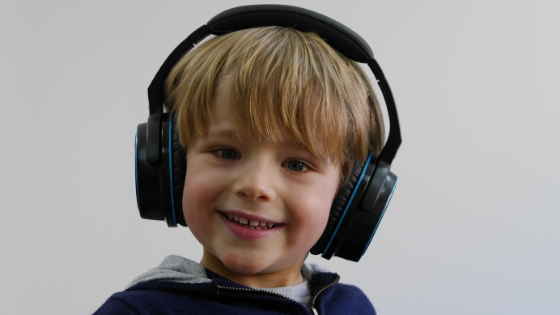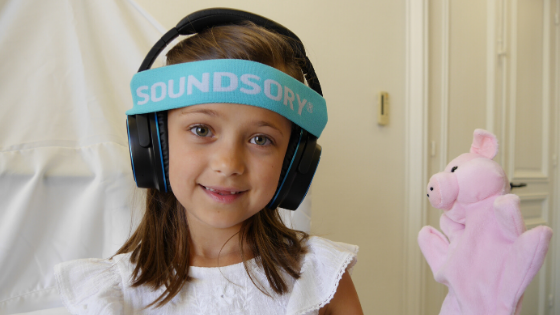In this blog, we would like to give you information on how to practically use Soundsory with your clients on the Autism Spectrum. We will cover the two biggest questions that always come up as well as provide few other tips and suggestions!
A 40 DAY JOURNEY!
The first topic we will tackle is this – How do you get the family of a child with Autism to commit to a 40 day program?
This is a question I often receive from therapists. Or when I talk with families directly they look at me with very wide eyes saying “Excuse me, 40 days?!" I always adapt my responses to the families that I have in front of me. What I typically recommend to families is to start with just a month, 30 days. Let’s commit to 1 month together and studies have shown that it takes 30 days to get new habits established! If that is still overwhelming for the family in front of you I will have them commit to 14 days. Plus I remind them that it is less than 30 minutes per day. This situation does not always happen but it is a situation that has happened and can happen so it is best to be prepared!
Most families of a child with Autism are really looking for something to help that individual and are willing to invest the time and money. They may not always have access to in person therapies or are looking for something to supplement their already established therapy schedule. This is a very motivating idea, that not only will it support what your families are already working on, it can also be used more than one time throughout the year. I am sure you have had families come to you looking for services and not being able to continue due to financial worries or time and distance. This is a great tool that could reach those families. If the family needs more convincing or motivation, here is another idea. If they happen to have more than one child the headsets can be used as regular Bluetooth headsets so siblings can use the headsets too by just connecting them to their iPad or iPhone via Bluetooth. When in this mode the bone conduction that we discussed in our previous blog is turned off so they are just getting very nice headphones to listen to your headsets. In addition this is a program that could be used with the whole family!
In most of the families that I have come across they really are willing to try the program to help their child. Of course this is never guaranteed as no therapy is every guaranteed to always 100% work but usually I start to see some changes and subtle differences within the first 14 days. So get your families to commit to the first 14 days and they I am sure will be hooked!
ACCEPTING THE HEADPHONES
This is the next big subject that comes up – “Not only do you want me to commit to a program for 40 days, you expect my child on the Autism spectrum who does not wear hats or like to have anything on his head, wear headphones”!
Parents often look at me like I am crazy! Having worked in the auditory world for many years, there are many ways to get individuals with Autism to accept headphones.

1. Introduce the headsets during your individual therapy sessions.
Pairing the headphones with highly motivating and rewarding activities. For me as an Occupational Therapist, I will bring out all my fun swings, games and toys that the individual in front of me likes. I will have the mom or dad or caregiver in the room with me so that they can provide support and comfort during this transition. Bubbles and visual distracting objects can be super helpful in these situations!
If you read the blog about Camille, a kid that I worked with before, we had is one to one aid in the session with us and we utilized some behavioral strategies. He loved watching this favorite rabbit show of his. We turned the sound off and would put the show on while he was wearing the headsets so that anytime he tried to take them off which did happen, the video was stopped and once he put them on the video was started again. You can imagine our first day was a lot of this on off on off. The next time a bit less, the next time even less and by the 3rd day he was able to come in put headphones on and engage with other activities without removing the headsets.
2. Using visual timers, charts, schedules can be helpful for both the child with Autism and their families.
A visual timer helps them understand when the music will start and stop. Adding schedules of all the things they can do when they are listening. The first few days you may need more highly motivating, preferred activities but after that you can introduce new ones. For older individuals having a calendar and checking off the days that they have listened. Or using some good old fashioned bribery. ?
For example after the 30-40 days, they get a small reward which you and the family can determine. Maybe they get an extra dessert or a trip to their favorite restaurant, or a small lego toy they have been wanting. You as the therapist know your families and what will work best for each of them.
WHAT CAN MY CHILD DO WHILE LISTENING?
This topic often comes after the first two biggies – “40 days" and “Accepting the headphones”. I will suggest things that you should not have your families do while wearing the headsets. We recommend that there is no other noise on in the background, so no other musical toys, games or television. We recommend that you don’t complete the program while in a moving vehicle (train; car; taxi: bus etc). The individual should not watch television or use any other electronic device during the listening. However, there is of course an exception to this rule if for example you are using it as a reinforcer without sound on as mentioned above for the first day or 2 is okay. A lot of individuals on the Autism spectrum tend to gravitate towards highly visual activities, TVs, wheels spinning, lights etc. For me I tend to stay away as much as possible from these types of activities. We also recommend that you don’t have the individual chewing gum or consistently chewing food during the listening sessions.

The great thing about this program is that it is all within the headsets that are wireless. There are an infinite amount of things the individual can do while wearing the headsets. Just remember to have the individual wear a headband and remind the parents to keep an eye out if the individual is doing more physical types of activities. The individual is free to move around and is encouraged to as well. They can complete physical activities, exercises, Yoga etc. If they have access to a backyard swing set they can carefully swing while wearing the headphones. They can complete more table top activities if that is preferred; coloring, lego building, drawing, writing, painting, any type of creative activities. This list can go on and on.
PROGRAM OPTIONS
Finally, I wanted to touch upon and discuss is the variety of program options. What I mean by this is that even though there is one program on the headset, there are infinite amount of ways to vary this program. I will give you examples of how I have been working with the program.
1. Stand-alone: 30-40 days
This is what I always have families commit to their first time through. I have found that this is the easiest way for families to follow the program, commit to the program and complete the program. Each day is clearly labeled 1.1 to 40.1. Following the completion of one program I will always allow for a break. After the 30-40 days I will allow a 4-6 week break depending on the individual and their growth and development through the program.
2. Maintenance: This is always done after one stand alone program has been completed
What I have used with families is a 2 weeks on; 3-4 weeks off model that has been working nicely. What I will have families do is pick a day to start with so let’s say they start with day 14, they will continue for the next 14 days of the program. After they have done this and had a break I will then have them randomly pick 14 days that they will listen to. These are just a few ideas knowing the individual and families I work with.
The great thing about this program is that the families purchase it directly so that they can use it multiple times and with multiple family members. You as the therapist have the best understanding and knowledge of your families so it will be up to you to create the program set up that works best for them.
We hope this information was helpful in getting you and your families started on their Soundsory journey. Please send us your feedback, we would love to hear about other topics you would like addressed in our articles.
Thank you for reading!

